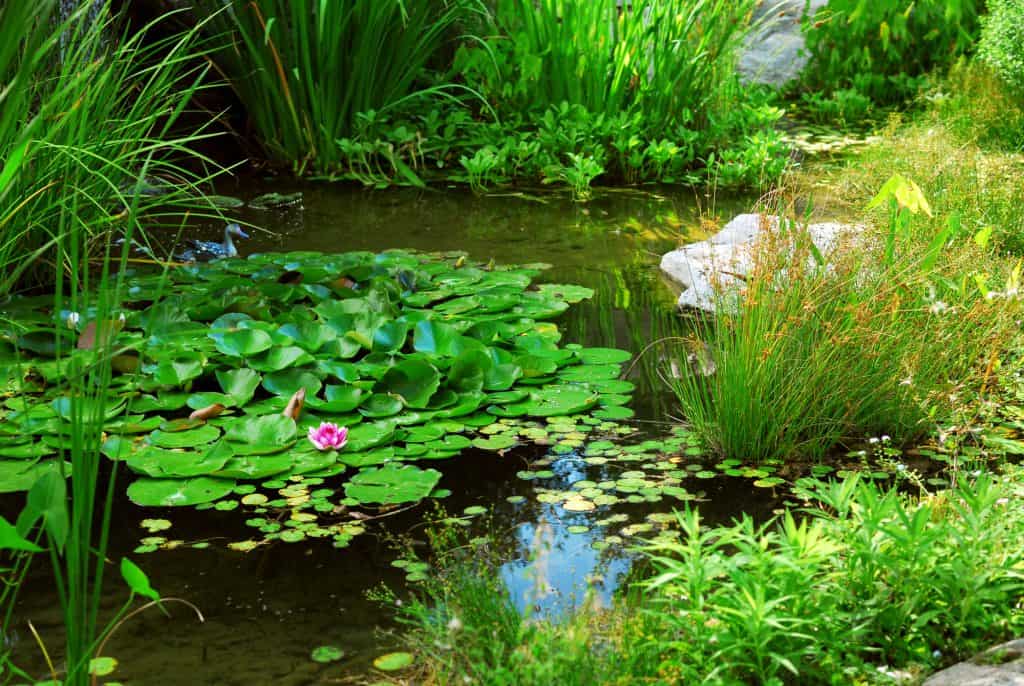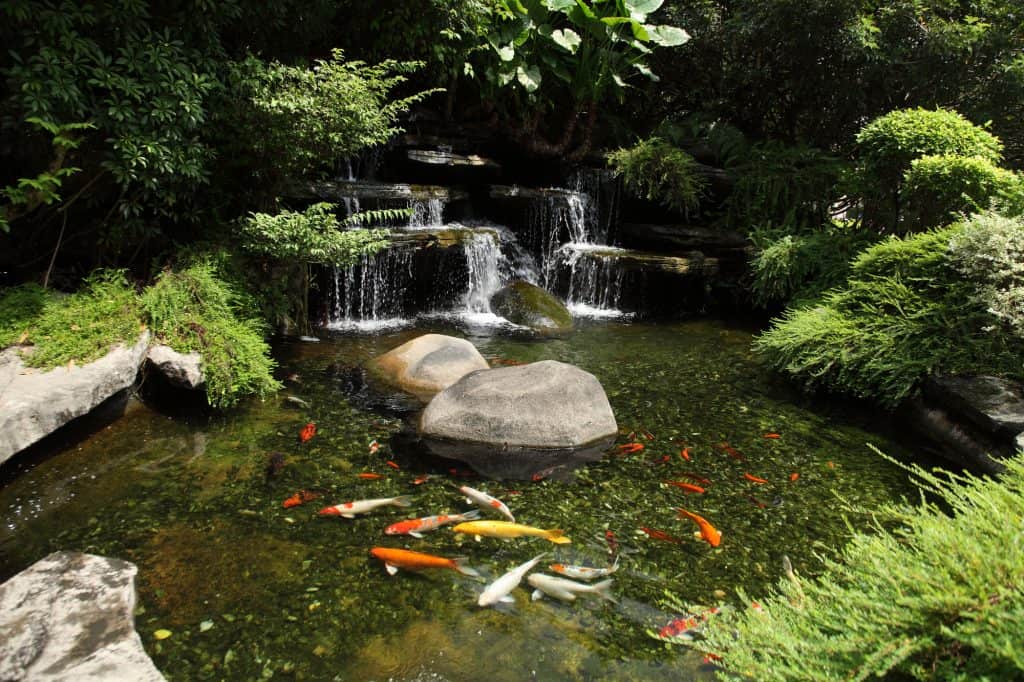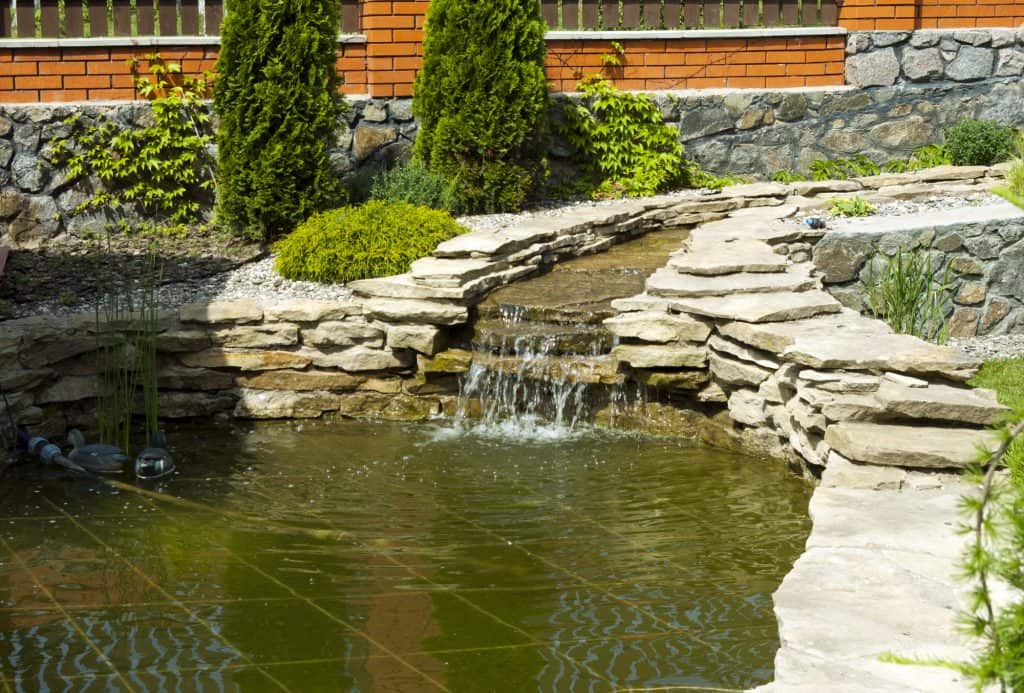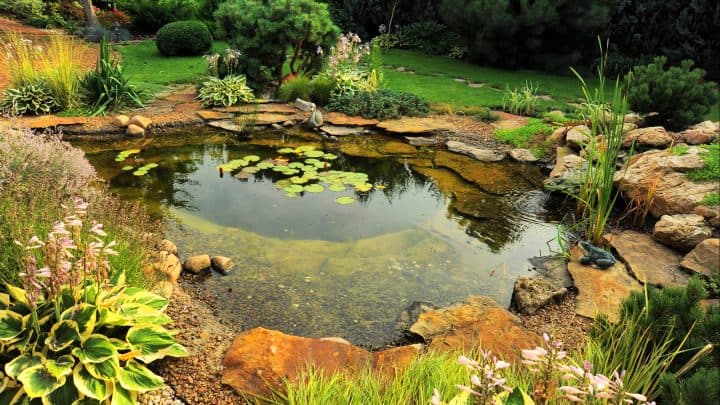Adding water features like ponds or fountains to your outdoor living spaces helps create a beautiful and tranquil environment. Not only does being around water increase the feeling of calm in humans, but animals and wildlife also benefit from a garden pond.
However, adding a pond to your outdoor space requires good planning, especially if you hope to make it blend seamlessly with the rest of the garden. That seamless aesthetic only comes when you can make your pond look as natural as it’s surroundings. So, how do you make a pond look more natural?
Generally, you can make a pond look more natural by varying the water depth throughout the pond, hiding the pond liner, adding fish and plants, placing rocks near the pond, and keeping it clean by reducing algae growth.
These things are easier said than done, so let’s dive in and explore some ideas.
Ensure there are shallow points
While you may not want a shallow pond, you want to include some shallow points in your pond design. Many experts recommend building your pond in steps, like a set of stairs.
Safety alert — Call your city or county before digging for your pond. This number is usually 411 in the United States. They will come out and mark where utility lines are buried so you can avoid costly damages, serious injury, or death.
The first step, or shelf, is the shallowest. This section of the pond is where the liner will attach.
This section’s shallow water allows plants to root and grow without a problem. This shelf is essential for pond health and sustainability, especially if you do not want to include a filter. Beneficial bacteria and organisms can collect and grow in shallow water.
Growing plants like reeds or cattails in this area will help filter the algae and prevent buildup from keeping your natural pond looking and smelling healthy. If your pond is smelling funky, or you’re afraid it might start, we wrote a guide on how to keep it smelling nice here.
If your pond is large enough and can support it, the next shelf will be a step between the shallow shelf and the deepest part of the pond. This area helps keep water moving and allows fish more room to swim.
The pond’s deepest part allows the fish to swim to the bottom during the winter. Many types of fish will be able to survive winter with this tactic.
If you are hoping to put in a filtration system or a fountain, pulling water from the deepest part of the pond will help keep the water moving. Stagnant water can increase the mosquito or other pesky bug populations and be a breeding ground for anaerobic, harmful bacteria.
Hide Pond Liner
Pond liners are essential when creating an outdoor pond. Most people choose to go with a plastic liner that will lay flat and fit amongst their pre-dug hole.
Others will choose to go with plastic tubs purchased at a local hardware or garden store. These tubs come in different sizes and shapes and are designed for the homeowner to easily install a pond in their yard with little guesswork.

No matter your choice, either option will look similar once dug into the ground. Some people even choose to line the hole first with plastic liner before placing the tub in, just as an added precaution.
Nothing seems natural about a plastic liner lying near a big puddle of water. At least, I’ve never seen such a thing lying about in nature. Luckily, there is a multitude of ways to hide the man-made liner.
You can hide your pond liner with either grass, rock, or plants. It is not recommended to plant trees near a pond as the roots can grow and damage the pond liner later on.
Add Aquatic Plants
When you think of a pond in nature, it is more than just a giant puddle of water. The pond is an entire ecosystem, including fish, insects, and typically a large amount of plant life.
Water lilies are beautiful and help add to the overall look of your garden pond, but there is so much more that goes on in a pond ecosystem. Water lilies alone will not be able to complete a natural-looking pond — you’ll want to branch out and find many different species to augment your pond.
Be sure to choose native plants to keep the ecosystem native and sustainable. Many foreign plants cannot survive the harsh winters since they are not from a cold region.

Additionally, aquatic plants include plants around the pond, not just in the pond. Not only do these perimeter plants help keep the pond clean, but they also add to the illusion of a naturally occurring pond.
You can easily add appeal by planting cattails, arrow arum, and pickerel rush around the pond’s edge. These and other aquatic plants will help create hiding spaces for wildlife to enjoy the pond water.
Some plants even offer habitats and food for animals as well. Frogs eat bugs, usually hiding in the tall reeds near your backyard pond. Frogs will also eat mosquitos which is incredibly beneficial for anyone who wants to sit around your pond in the evenings or after dark.
Place Rocks Around Feature
After you have dug your pond and lined it appropriately, you will end up with a black liner spilling over the pond’s edge. While the liner must be a foot or two over the edge of the pond to help prevent any leakage, it is not the most natural looking or aesthetically pleasing to look at.
Fortunately, a simple solution that adds curb appeal and function: landscaping rocks. Placing rocks around the pond’s edge helps create a natural landscape that allows plants to root and helps the pond liner blend into the surrounding areas.
Choosing gravel with large stones or small rocks as accents is a great way to ensure visual interest. Gravel tends to be cheaper than larger rocks. However, river rocks are a natural choice.
These rocks are slightly larger than gravel but are more appealing and less out of place. They are also easy to find. You can even order them by the ton from a landscaping supply company if you do not want to deal with lugging around 40 bags of rocks.
Add height variety by placing larger rocks and stones around the perimeter of your backyard pond. Larger stones and boulders can serve as places to set plants or other outdoor decorations. You can also hide your pump or hardware in between rocks or purchase hollowed-out plastic rocks that will cover your pump entirely.
Introduce Fish

Introducing fish, like koi or goldfish, to your pond is another great idea. As the fish swim through the water, they are causing the water to continuously move, reducing the chance of stagnant water buildup.
Koi, like frogs, will also eat pesky bugs like mosquitoes and other insect larvae. While fish do their parts in keeping the pond clean and running smoothly, adding too many fish can cause issues.
If there are more fish than the pond ecosystem can properly support, many things can go wrong.
Fish, like all living things, create waste. Too much fish waste can interfere with the water’s oxygen levels, which can choke out the plants that root in and near the pond. In addition to harming the plants, it leads to algae buildup and can become unpleasant in smell.
Goldfish and koi fish can live between 10-15 years if well cared for.
Keep it Clean to Reduce Algae Growth
Ponds can become dirty very quickly. Grass clippings, leaves, and even bugs can end on the water’s surface, making a murky and unpleasant pond. Ponds cluttered with man-made or natural garbage can create a breeding ground for larvae, insects, and bacteria.
This is why all ponds need some sort of a filtration system. Filtration systems can either be natural or manufactured but are necessary for keeping your pond clean and safe.
Natural filtration systems rely on microorganisms and filtering plants as their tools to keep it clean and functioning.
While this approach requires less upfront investment, keeping the ecosystem in tip-top running condition can be difficult and requires careful maintenance. This is especially true after heavy rainfalls.
The easier option to install is to invest in a manufactured system. You can still choose a natural-looking option, though. Many filtration systems have submersible filters that sit below the water’s surface. Other cords, plumbing, or pipes can be hidden in foliage or landscape rocks.
Consider a Waterfall or Other Water Features

If you are toying with adding a filtration system to your backyard pond, consider adding a waterfall or fountain. Waterfalls create a relaxing ambiance and can even help keep the pond cool.
You will love the soft sound of running water, and this simple detail can make even small ponds seem magical and natural.
Waterfalls and fountains require additional mechanical systems and are easiest to install before filling the pond with water. As we talked about earlier, many pond owners like their water feature to pull water from the bottom of the pond to help keep the water circulating.
However, some fountains are solar-powered, meaning you do not have to worry about the electricity required, annoying cords, or being concerned about too many things being plugged into your outlets.
On the same note, you want to ensure that anything you have plugged in is plugged into a GFCI outlet. These outlets are designed to be outdoors and will throw their breaker if they come in contact with moisture, lessening the chance of electric shock.
Conclusion
Creating a natural-looking pond does not have to be stressful. While there are many details, you must plan for and remember, at the core, just remember what you would find near a natural pond. Adding plants, rocks, landscaping, fish, and waterfalls and keeping the pond clean and beautiful are all things that help your pond look inviting and relaxing.

